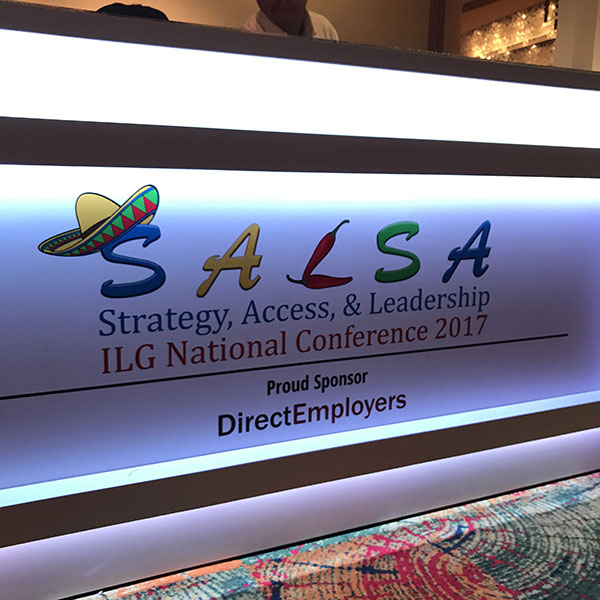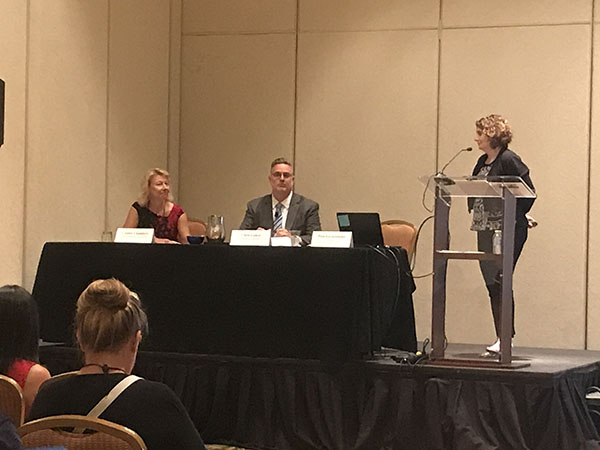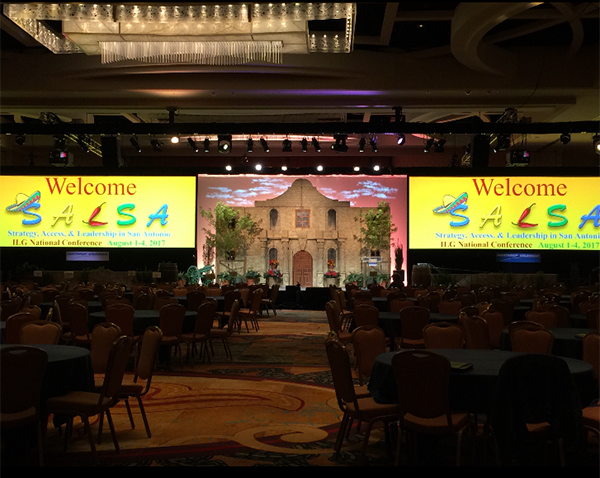Recently, we had the pleasure of attending the Industry Liaison Group (ILG) National Conference where we took time to network, learn from regulatory officials and have a little fun along the way. This year marked DirectEmployers 12th year participating in this conference and we have seen some major changes over the years. With bold colors and an energizing opening ceremony, this year definitely didn’t disappoint in bringing some great presentations and a continued message of equality and inclusion. The following are some of our takeaways from several of the key sessions.
Day 1: Opening General Session with Tom Dowd
Tom Dowd, the interim Director of the OFCCP, began his keynote by framing a few facts for his discussion. Notable facts included the Department of Labor’s (DOL) budget and the portion that is actually appropriated to the OFCCP.
The DOL budget is about 12 billion and 10 billion of that supports the Employment & Training Administration (ETA), which leaves about 2 billion for the rest of the DOL agencies. Of the remaining funds, the OFCCP’s budget is 104 million–which makes it one of the smallest agencies in the DOL.
Another fact is there are around 25,000 federal contractors and 180,000 establishments. The OFCCP has a staff of 563, and Dowd remarked, “You might say we are like a dot on the sun. There’s way more of you than us, and there’s no way we can evaluate all of those establishments.”
His final fact was that the OFCCP only finds discrimination in roughly 2% of evaluations they conduct. From 2007-2017 they evaluated 40,000 establishments and of those, 40 went to litigation. That’s only 1%! The majority of the evaluations resulted in a notice of compliance or they were resolved with a notice of conciliation.
During his final remarks, Dowd said he is interested in finding new and creative ways to provide compliance assistance because, “…our job is to respect the people.”
Key Takeaways:
- “Let’s work together to create compliance!”
- Myth: If you ask OFCCP for compliance assistance, then you will be scheduled for review. Truth: That’s simply not true because that’s not how the OFCCP does its scheduling. To help dispel that myth, the OFCCP has been working through an idea of offering compliance assistance training. Once the training is completed, the contractor would receive a certificate and won’t be placed on the scheduling list for two years.
- Bring back the public acknowledgement of the federal contractors that are leading the way on affirmative action and equal opportunity. Your companies are helping make sure OFCCP does compensation right and pay equally so you should be recognized for pay equity and leading the way in hiring veterans, individuals with disabilities and minorities.
- Finally, if a large company came to the OFCCP and said, “Look at our entire company,” OFCCP would say if that there’s any compliance issues, we’ll work together to fix them, or if there aren’t any then we will leave you alone for a few years.”
Dowd said that he thought it was important to have all of the regional directors present at the conference (first time ever) because it is so important that the various areas work together. He concluded by stating, “I’ve threatened that I’ll be here all week. Please introduce yourself and let’s talk.”
Day 2: Opening General Session with Victoria Lipnic
Victoria Lipnic, Acting Chair of the EEOC, had a very similar sentiment during her remarks to the attendees of the 2017 ILG National Conference. She stated, “We want to work with you when we conciliate matters, and when we have litigation, we want to find out how we can work together to mitigate these barriers.”
Lipnic also highlighted some facts including that there are 5.6 million jobs that are going unfilled, yet we have 7.5 million unemployed and 1.8 million that are long-term unemployed. After letting that statistic sink in, she commented that she wants to work together to understand where the gaps are so that we can work to eliminate them now.
She stated that we are at a critical time in our country with the discussions being had at home and in the workplace about diversity and pluralism being incredibly important. In light of the recent 50-year anniversary of the Age Discrimination in Employment Act of 1967 (ADEA) she said, “I like to say that the ADEA has finally reached middle age.” Explaining that at 50, the ADEA is more relevant than ever, considering nearly one in five Americans age 65 and older are working today. In addition, the highest rate of entrepreneurial activity belongs to those aged 55 to 64, busting the myth that older workers are not innovative or technically inclined. Lipnic stated, “I hope we will move beyond outdated assumptions. The principle of the ADEA is that ability matters, and not your age.”
Finally, Lipnic state that the EEO-1 needs to be resolved, and she is pushing for a resolution by Labor Day of 2017.
Key Takeaway:
Let’s Work Together To Create Compliance! Sound familiar?
Following is a recap of other sessions we attended and what we found noteworthy!
Fostering Change: Developing Strategic Alliances with State Workforce Agencies
Presenters: Candee Chambers with DirectEmployers, Chris Liakos with Northrop Grumman, and Pam Gerassimides with NASWA
Are you aware of all of the services that the states provide to employers?
States provide the following specialized services to businesses:
- Job banks and resume banks
- Rapid response and layoff aversion
- Downsizing businesses, labor market information (LMI), info on tax credits, etc.
- Recruiting and hiring connections
- Veterans services, WIOA, job fairs (Veterans with “Significant Barriers to Employment” are served at CareerOneStops by JVSG staff known as DVOPs – this involves case-management and use of supportive services. Veterans without SBEs are served by other CareerOneStop center staff, where they receive “priority of service” to any services states and one stops offer. By design, most veterans are AJCs served outside JVSG.)
- Special or personalized account representatives
- Worker training
- National Labor Exchange (NLx)
One of the basic steps to work with the state workforce agencies is to get your jobs in the NLx database.
All 50 state workforce agencies and three territories (Guam, the District of Columbia and Puerto Rico) have signed data sharing agreements so this is the easiest way to ensure your jobs are listed with the state workforce agencies.
Other Benefits of the NLx:
- Increases job seeker traffic while keeping brand prominence
- Lists job openings with state, federal, and non-profit portals and accesses diverse talent pipelines
- Connects with state workforce development employer services
- Automates daily delivery to CareerOneStop offices and state job banks to comply with 4212/VEVRAA regulations
- Analytics and understanding of the data to show where the competitors are and what jobs they have so you can get more bang for your buck
- All jobs in the NLx are being sent to LinkedIn as well as various other partners like Google; Student Veterans of America (SVA); Veterans Clearinghouse; AfricanAmericanJobsite.com; Diversity.jobs; EasterSeals.jobs; Women For Hire; and many more
Key Takeaway:
There are a lot of free services you may not be aware of! Contact your state workforce agencies and take advantage of these services to further your recruitment and compliance strategies.
Litigating an Administrative proceeding against OFCCP
Presenters: Michelle L. Duncan and Daniel V. Duff, Attorneys with Jackson Lewis P.C.
In recent years, the OFCCP has been focusing on adverse impact, pay discrimination and specific minority analyses. If you are thinking that a Republican administration will be less aggressive, you may be mistaken. Duncan stated, “With the end of the Obama administration and the dawn of the Trump administration, we need to be prepared. Many of the largest cases litigated were under the Bush administration. The OFCCP is a law enforcement agency and they have an obligation. Therefore, we won’t see a change in the aggressive approach.”
Duncan explained the trend that they are now seeing is that federal contractors are no longer receive a pre-determination notice (PDN). However, most are receiving a Notice of Violation instead.
The majority of these Notice of Violations (NOVs) fall into one of the following:
- Technical violations (Record-keeping, listings, etc.)
- Denial of access
- Discrimination
Duff summed up his remarks with an acronym QUIC:
- Quick: the cases are not fast – they can take several years.
- Uncomplicated: these are not easy cases, these are not arbitration
- Inexpensive: these cases are not inexpensive; time and resources at the client are extreme; and if counsel represents you, there are payments for attorney fees.
- Confidential: these proceedings are not confidential, like arbitration. It’s a public hearing and the press can be present.
Duff went on to share some common pitfalls including:
- Failing to involve the right decision-makers
- Failing to assess all of the risks
- Using the right kinds of experts
- Unfamiliarity with OFCCP
- Unfamiliarity with the process
- Not knowing the facts and data of your case
Key Takeaways:
- Don’t be bullied by OFCCP – the Agency has the burden of proof
- If litigation looks possible, do your research on the issues and the process
- Gather as much informal discovery as possible prior to litigation
- Remember litigation holds and insurance notification
- Know that the Solicitor’s Office is often a check on OFCCP (very few cases are litigated in any given year)
- Assemble your litigation team early and have a plan to aggressively defend against any meritless allegations
Duncan and Duff both reiterated that this is complex class action litigation. So make sure that you’re aware of that and ready to fully engage.
Using Social Media
Presenters: Jayde Ashford Brown, Associate and Marc Katz, Partner both with Andrews Kurth Kenyon
Of course we all know that the OFCCP is focused on discrimination in the hiring process. The presenters sited two recent OFCCP settlements:
- A food service contractor ordered to pay $550,000 for entry-level females and make 53 job offers
- A specialty chemical contractor was ordered to pay $175,000 and make 6 job offers to African Americans
When looking at the use of social media in the hiring process it’s first important to revisit what is considered an Internet applicant:
- The applicant must make an expression of interest
- The applicant has to meet the basic qualifications
- At no point prior to receiving an offer can the applicant rescind their interest
When considering using social media in the hiring process there are some pros and cons to consider:
- Pros: Cheap, free, fast
- Cons: Lack of access to information that can be used for discrimination; inconsistent and unreliable information
Finally, the presenters provided us the following best practices when using social media in the hiring process:
- Create a firewall between the hiring decision-maker, and the information that otherwise might lead to discrimination
- Create a social media policy
- Provide thorough training and make clear what can and cannot be done
- Don’t request username and passwords from employees or applicants
When creating a social media use policy, make sure it is clear. As we all know, everybody is on social media so you cannot have a policy that is going to deny the use of social media. What you need to do is create a policy on how it is acceptable to use social media. Have a clearly defined process on who is going to search for what, where are you going to store the information that you have procured, who will have access to the information, and finally provide training that clearly outlines your policy. If you don’t have a strong and clear process on how you’re making hiring decisions then it can be difficult to disprove your reliance on your searches on social media.
In conclusion, the presenters stressed that you can control your liability by defining the correct timing of when you allow social media into the process.
Key Takeaway:
The use of social media in the workplace is still very ambiguous, so be careful.
If we were to share each of the amazing presentations from this year’s conference, this blog post would be a mile long! Each of the presentations were notable, with great learning points, but we do want to mention the great keynote from Dr. Adam Saenz presenting, Why You Are Biologically Hardwired To Fear Differences. If you haven’t had the pleasure of hearing him present, we highly recommend you watch his Tedx Talk here: https://www.youtube.com/watch?v=AyogyD7vXbw
We’re already looking forward to next year in Anaheim!





